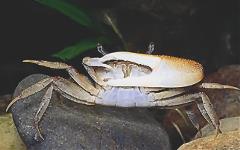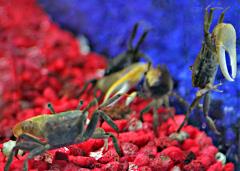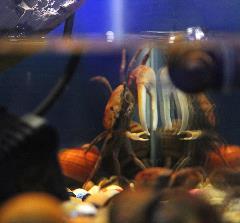| Feb 15, 2017
Mini Crabs & Fiddler Crabs
Fiddler crabs in the wild can be found scuttling across sea beaches as well as brackish inter-tidal mud flats, lagoons, and swamps. However, the usual mini or fiddler crabs you can find at your local pet store are semi-terrestrial brackish crabs, which will mean they need some aquarium salt in their water as well as access to occasional air and dry land. These small crabs enjoy eating flake, thawed freeze-dried, pellet, or thawed frozen foods in captivity - alternating proteins and algae foods. The movement of the smaller claw from the ground to their mouth during feeding illustrates the crabs' common given name; it looks as if the animal is playing the larger claw like a fiddle!

In order to eat, the crab's smaller claw picks up chunks of sediment from the ground, bringing it to its mouth, and sifting through the sand and soil for anything edible before rolling up what is left into a tiny ball. The presence of these types of sediment balls near the entrance of a sand burrow is a good sign of a crab living there. Their diet makes Fiddler crabs “
detritivores”: meaning creatures that gain nutrition from eating decomposing plant and animal material. Scientific research suggests that the feeding habits of fiddler crabs play a vital role in the preservation of wetland environments - by sifting through the sands, they aerate the substrate and keep the soil saturated with air.
Fun Fact: Fiddler crabs exhibit a constant
circadian rhythm in a controlled setting that imitates the ebb and flow of the tides. This makes the crabs turn dark in the day and light in the dark!

Fiddler crabs are most well known for their
dimorphic claws; the males have one larger, dominant claw than the other while both females’ claws are the same size. Fiddler crabs communicate using a sequence of waves and gestures with their claws, but that's not all! Males also use their claws for confronting other competing males in ritualized combat during mating season or waving during courtship to attract female crabs. Females then choose their mate based on claw size and also quality of the waving display.

Scientists believe that the male major claw size can also be correlated with burrow width as the width of the burrow influences incubation temperature. Therefore, the female will choose a male mate whose claw size indicates the best fit for the burrow environment for her clutch of eggs.
Like all crabs, fiddler crabs shed their shells as they grow. If they have lost legs or claws during their present growth cycle, a new one will be growing when they molt. If the large fiddle claw is lost, males will begin to develop one on the opposite side after their next molt. Newly molted crabs are very vulnerable because of their soft shells, so it is best to leave them to molt and recover peacefully. Don’t be alarmed to find a molting Fiddler crab lying on its back as this is normal! During a molt and shortly after, they are reclusive and hide until the new shell hardens. If you leave their shell in the enclosure afterward, though, they will eat the remaining discarded shell for it is a good source of calcium!

Fiddler and other mini crabs require at least a 5-10 gallon tank, with preferably as many as or fewer than 4 crabs per 10 gallons.
Be careful choosing a filter and aquarium top, too, as they are
amazing escape artists and will often climb away to hide in your filter or be found outside your aquarium! This is also why providing a place for them to hide in the enclosure and substrate in which to burrow is so important as well. Fiddler crabs do well at a range of temperatures between about 72-85 degrees Fahrenheit and an additional heat source may be needed to maintain this temperature. They live up to 2-3 years, are nocturnal, and typically grow only approximately 2-3 inches wide.
Right now, you can take home these adorable little invertebrates for only
2 for $7.99 until March 13th at Uncle Bill’s Pet Centers!